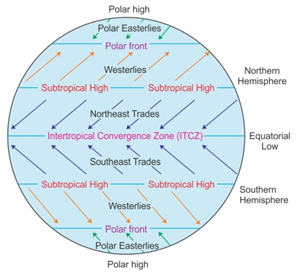Explain the following pressure belts with the help of a suitable diagram:
- Equatorial Low Pressure Belts
- Sub Tropical High Pressure Belts
- Circum- polar Low Pressure Belts
- Polar High Pressure Areas

The four major pressure belts of the Earth are:
- Equatorial Low Pressure Belt
- This belt lies between 0°N to 5°N and 0°S to 5°S
- Since the vertical rays of the Sun fall on the Earth, the heat is intense and the temperature is high. The air becomes warm and expands.
- The convection currents also help to spread the heat to the upper layers of the atmosphere.
- This leads to the creation of a low pressure belt in the region. Winds in this pressure belt do not blow at a fast pace and hence this belt is also known as the Belt of Calms or the Belt of Doldrums .
- Sub tropical high Pressure Belt
- This belt is located between 30°N to 35°N and 30°S to 35°S.
- As the air at the equator moves toward the Poles, it begins to cool and sink down at about 30° North and South of the Equator. This creates the areas of high air pressure.
- Due to the rotation of the Earth, air from 60°N and 60°S also descends in the sub tropical belts.
- This pressure belt is also a belt of clams and is referred to as the Horse Latitudes .
- Circum Polar Low Pressure Belt
- This belt is located between 60°N to 65°N and 60°S to 65°S.
- It is a zone of two winds; the warm Westerly winds meet the cold polar Easterlies. As the Westerlies are lighter, they rise over the cold polar winds creating a low pressure area.
- These belts experience stormy weather and cyclonic activity especially during the winters.
- Polar High pressure Belts
- This belt is located between 85°N to 90°N and 85°S to 90°S.
- The Polar Regions experience cold climatic conditions as the rays of the Sun are extremely slanting.
- The cold air sinks down giving rise to high pressure areas.
- In these places the temperature is permanently low, and the air is dense and heavy. These Polar Regions have permanent ice caps.